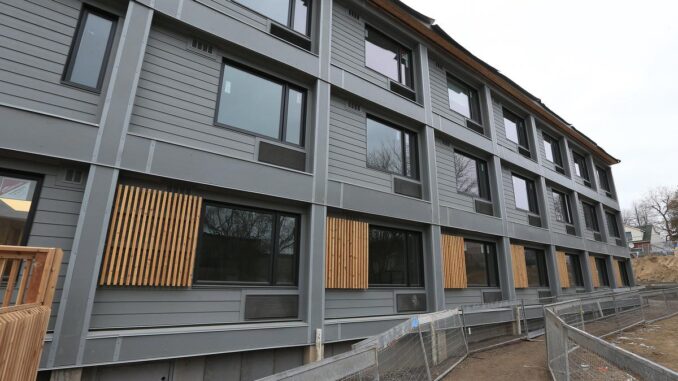
City of Toronto creates new shelter design guidelines building on best practices and advice from those with lived experience
The City of Toronto has created new Shelter Design Guidelines based on extensive consultation that lays out best practices in the design of new permanent shelters in Toronto.
The Guidelines include a broad range of areas from design approaches and principles, through to functional components of the building, environmental design and materials and finishes. The Guidelines incorporate directives already in place to reduce the spread of COVID-19 in the shelter system.
The Guidelines include input from a wide range of stakeholders including Indigenous people, Black people, people of colour, LGBTQ2S+, those with accessibility needs and youth who experience homelessness.
Some key elements of the Guidelines are:
• Adding community space inside the shelter to help integrate the site into the neighbourhood
• Making sites more accessible for those of different cultural backgrounds, ages, shapes and sizes, physical, sensory and cognitive abilities, gender identities and needs
• Creating a welcoming, more home-like setting with pet-friendly options, less institutional design and more natural light
• Focusing on supporting the needs of persons who have experienced trauma and providing support for cultural and spiritual practices
• Helping build confidence, independence and emotional well-being
• Providing privacy and offering choice, while not sacrificing safety
• Creating space for positive, safe relationships between shelter users, staff and community
• Supporting measures for infection prevention and control, harm reduction approaches, and physical and mental health supports
• Incorporating sustainable, durable and resilient design, so City shelters are effective in minimizing energy use and operating costs
The Guidelines are intended to assist those designing and building shelters to incorporate best practices and lessons learned through use of existing shelter facilities, so that new and renovated sites respond to evolving needs of those experiencing homelessness. The Guidelines www.toronto.ca/community-peopl
Some City-owned locations that have recently been renovated incorporating elements of the Guidelines include 3306 Kingston Rd., 731 Runnymede Rd. and 2671 Islington Ave. These locations are pet-friendly and offer smaller shared sleeping spaces. Sites that are currently under development or construction will include many of the best practices outlined in the Guidelines.
Interim COVID-19 response measures that have been incorporated into existing shelters and are referenced in the Guidelines include:
• Active screening of staff, clients and visitors; temperature checks and physically distancing beds;
• Distancing for daily living spaces, including separations within dining areas; outdoor amenity spaces; specialized program space;
• Enhanced cleaning and Infection Prevention and Control (IPAC) and mandatory mask wearing in common areas.
The City’s has also responded to the COVID-19 pandemic by updating the Toronto Shelter Standards and the 24-Hour Respite Site Standards in accordance with public health guidance.
The Guidelines are part of the City’s response to the complex needs of those living in encampments and those who don’t traditionally use shelters, to help ensure shelter services are welcoming and encourage individuals to come to safer, indoor spaces offered to them. The City shelters more than 6,000 each night and has worked with our agency partners to refer almost 1,250 individuals outside into safer inside space between mid-March 2020 and January 5, 2021. Outreach is done by the City and partners 24/7/365.
The Guidelines are intended to help foster more positive outcomes and experiences for all shelter users, staff and the community through designs that promote dignity, comfort and choice for people experiencing homelessness and prepares them for independent living.
Quotes:
“The City of Toronto has responded to help our most vulnerable population during the pandemic with enhanced supports, a dedicated isolation and recovery site for individuals experiencing homelessness that was the first of its kind in Canada, adding more than 25 new sites for physical distancing and expanding our Winter Services Plan. These new Shelter Design Guidelines incorporate lessons learned and best practices to continue to improve services for people experiencing homelessness as we move people into permanent housing.”
– Mayor John Tory
“These Shelter Design Guidelines offer guidance for the City and private sector on how physical improvements can be implemented in existing and new shelters as they are renovated, designed and built this year. These Guidelines will continue to be updated to be useful in years to come not just as a blueprint on how to improve built structures, but with tangible ways to enhance the experience of our most vulnerable residents who reside in shelters as we support them to move towards more independent living.”
– Deputy Mayor Michael Thompson (Scarborough Centre), Chair of the Economic Development and Culture committee
“The Shelter Design Guidelines are based on input from staff, partner agencies and those with lived experience, so new and renovated shelter sites feel more welcoming and less institutional. Our goal is that sites include designs that foster more healing as people deal with trauma, substance abuse and mental health and move towards a place of their own with support. We have taken some of the best practices from existing shelters so new and renovated sites are better integrated into the community, provide more natural light, dignity and choice.”
– Mary-Anne Bédard, General Manager, Shelter, Support and Housing Administration
SOURCE: City of Toronto

Leave a Reply